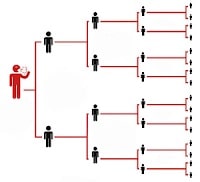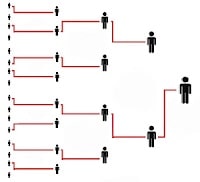Coronavirus endgame: how we get back to normal
(Same disclaimer as before: I'm not a medical or public health professional, listen to them over me if they contradict me in any point in their expertise. I do have this to say for myself, though: my last two articles have played themselves out quite well in the progression of this coronavirus pandemic.)
The current state of things
Mere hours after I published my last article, the San Francisco Bay Area got a "shelter in place" order. Since then many other cities and states have followed up with similar orders. I haven't tracked all such measures, but much of the United States is now in some form of lockdown. I feel like the societal mood has very much changed, to where people are now, finally, taking this seriously.
We are approaching the endgame now. Where do we go from here? And how do we get things back to normal, as quickly as possible? Some people are fantasizing an apocalyptic future, where we stay locked in for months and venture into the virus-infected outside world only to fight over food and toilet paper. Is that what lies ahead? It's clear that our current level of suppression cannot persist indefinitely, but how will it end, and what will life look like when it does?
First, let's go over some good news. Lockdowns are easy to implement, and they work. Once every infected person infects fewer than one additional person on average (R0 < 1), the mathematics of the exponential function now work against the virus, and its numbers collapse with the same rapidity it had during its growth. South Korea and China had already broken the exponential growth long ago, and now, with the latest numbers, it looks like Italy has turned the corner as well, as I said it would.
The major population centers for the U.S (in particular the SF Bay area, where I live) should also reach this point in another week or so. There are other parts of the country where the virus started later, so they will be on a time-delay from the major cities. Again I can't keep track of the different levels of infection all across our vast and diverse country, but in any given area, once your city is in lockdown, the virus will die down in a matter of a few weeks.
What then? If we simply go back to normal, the virus will just flair up again, and we'd be right back to where we started. So does that mean we have to stay locked in indefinitely? That's clearly unsustainable. Fortunately, there's an easy way forward - one that is easy to implement, keeps the number of infections and deaths low, and restores us to mostly "normal life" in just a few weeks.
The way forward - phase 1: lockdown
First, we stay locked down until the worst passes. The healthcare systems are bracing for impact right now, and more infections now will worsen their caseloads and the outcomes for their patients. Stay in your homes, and help out your neighbors and local businesses while maintaining social distancing.
In the meantime, our testing capacity needs to increase massively. Things have certainly improved in testing since the botched initial rollout, but I believe we have much more to do. The rest of this plan hinges on accurately measuring the level of infection in the population, at each local level - every state and every city. We will need enough tests to detect infection levels like 0.01%, everywhere in the country.
In any case, with the lockdown, the numbers will decline. The medical professionals will get slammed for a short time and heroically fight their battles. They will come out victorious on the other side, because the virus will have been starved of new victims. At this point, we can start the next phase of the plan.
Understanding R0

Every sick person infects two others,
and the infection continues to grow.
To understand the next phase, we need to understand something very simple about how a virus spreads. An infected person will eventually recover or die. In that time, if they've caused more than one additional infection (on average), then the disease will continue to grow and spread. But if they've caused less than one additional infection, then the disease will shrivel away. This number - the number of additional persons that an infected person infects - is called R0, and for the coronavirus, if we do nothing, it's about 2-3. The goal of all our personal hygiene and social distancing efforts is to reduce this number, so that the infection dies down.
The other important thing to know about this number is that it succinctly expresses the entire power of the virus. If this value cannot be brought down below 1, then the virus will continue on its rampage until it inevitably infects a huge portion (~60% or so) of the population. This is the catastrophe we are trying to prevent. It is this scenario that holds all our fears. In contrast, the current numbers, as large as they seem, are trivial for a population our size. They're still "no worse than the flu", in the commonly misused phrase of a few weeks ago. What we're really worried about is how these these numbers will grow, under the assumption of exponential growth.

50% chance of passing on the
virus, and the infection shrinks.
That is why we must break that assumption. We do that by reducing R0 < 1. In fact, I think "flatten the curve" is the wrong motto. It should have been "break the (exponential) curve". We must take those exponential hockey-stick growth curves of infection and death, and break them right in two - into the growth curve, and then the decay curve. Again, we do that by keeping R0 < 1. As long as it's kept below 1, then it doesn't matter what else we do: the infection will inevitably wither away.
Now, while the coronavirus can be suppressed in this way, the consensus expert opinion seems to be that complete eradication is basically impossible, especially without a vaccine. So even when we get over our current hump, we will continue to live with the reality that there will be new cases popping up, everywhere on the planet. The second part of the plan is to keep such cases suppressed, so that they don't simply reset us back to the beginning.
Phase 2: permanent R0 < 1
We continue the suppression by keeping a permanent environment of R0 < 1. But what does that mean, in practical terms? Does that mean a permanent state of lockdown? Not at all. The current lockdowns are necessary because we were basically caught flat-footed. They are drastic measures that reduce R0 down to values like 0.3 - far less than 1. We're implementing them because the possible impact to our health care systems needs to be reduced NOW, and we don't know what else to do. But with the time we have in this lull, we can think of new, efficient ways to reduce R0 - ones we can carry out easily and indefinitely.
Think of it this way: to reduce R0 from 2 or 3 to down below 1, we just need to reduce the chance of infection by 50-70%. Every little thing we're doing - hand washing, staying more than 6 feet apart, etc., helps reduce this value. We just need to find enough of such measures to reduce R0 by about 70%.

There's bound to be a relatively easy way to do this, without requiring full lockdowns. It may be as simple as "everyone wears a face mask". Consider: if the sick person's face mask reduces transmission rates by 50%, and the possible recipient also gets a 50% reduction from their face mask, that's a total of 75% reduction. R0 < 1. Done.
The numbers in the above example are made up, of course. But we will learn such numbers soon. If a face mask alone is not enough, maybe we'll need face mask plus face shield, or maybe face mask and gloves. But think of it: it may be that we can all go back to "normal", with a simple additional measure like "everyone wears face masks". Some combination of such cheap, easy measures should reduce R0 to below 1.
How do I know this is possible? Because South Korea is already doing it. They have the coronavirus well under control, and they've never had to do shut down whole cities to do so. And how will we know that this is working, once we get there? That's where the massive testing comes in. We will know whether we need to increase or decrease our suppression efforts, because we will actually have the testing data showing us the accurate infection level. Basically, the testing and the suppression efforts will form a negative feedback loop, where we take more stringent actions if the infection rate in the population is higher - all the way up to another lockdown if necessary - and we relax these measures when the infection rate is lower.
Phase 2 example
This gets us back to "normal" - admittedly with some light additional measures - in a matter of just several weeks. But another beauty of this plan is that it can be implemented anywhere, any time. You don't need to wait for the federal government to swoop in with some trillion-dollar plan to start.
Say, for instance, that you're a small city in a state with a low infection rate. Nobody in the city is known to be sick with the coronavirus. But everyone is panicking! It's all that the rest of the country can talk about! Should you lock down the whole city right now? That does seem to be overblown, no? With zero known cases in the city? But then, what should you do?
According to the plan, you're effectively already past phase 1 - the "lockdown" phase - so you should implement phase 2: permanent R0 < 1. If I were this city, I would take all the cheap precautions I can without interrupting daily life. These may include:
The usual measures:
Hand washing, don't touch your face, keep 6 feet apart from other people, cover your coughs, stay home if you're sick.
Some enhanced measures:
Everyone wears a face covering of some kind (face masks are currently in short supply and should be reserved for health care workers), with more extensive protection for those that meet many people. Frequent cleaning of all public surfaces (door knobs, elevator buttons, etc), hand sanitizers and paper towels near all such surfaces, daily cleaning of all crowded areas.
Some easy social distancing:
Staggered work hours to keep public transportation less crowded, restrictions on large gatherings, restrictions on building occupancy, encourage working from home, clear plastic partitions between parties in crowded spaces (school desks, restaurant tables).
Frequent health checkups:
Full testing is ideal - but falling short of that, frequent temperature checks. Frequent reports from hospitals on people coming in with potential coronavirus symptoms.
Again, I am not in public health, and the above list is mostly just off the top of my head. This is just an example. It isn't meant to be a strictly prescriptive list. But the point is that this hypothetical city will still be fully functional, while significantly reducing R0. And it can stay with these measures indefinitely, because they are not overly burdensome.
And when this city gets its first confirmed case of the coronavirus, it will be dealing with only a handful of other possible infections, instead of the dozens or hundreds that a single case may imply without any measures. They should then immediately put in heavier measures for a short time afterwards, and when things are back down to zero active cases, lift these measures again. In such a way, our society can persist indefinitely, with a mostly "normal" life, while keeping the virus suppressed.
Summary and Victory
So that's the plan: for areas that are heavily infected now, lock down until the infection rate gets low enough. That's phase 1. Then, implement enough measures to keep R0 < 1, while maintaining a functioning society. Test extensively to provide feedback, so that we know whether we're doing enough. Respond to the test results by adding or removing the measures, so that we can keep R0 < 1, while maximizing society's activities. That's phase 2.
The final victory will come with the development of a vaccine, or an effective treatment. But that is a long ways off. Meanwhile, we'll be just fine, carrying on with daily life with some additional measures - light measures that can be borne indefinitely.
A much more thorough explanation
Many of you will have already read or heard of Tomas Pueyo's excellent article, Coronavirus: The Hammer and the Dance. I highly recommend it. It covers essentially all the same things that this post does, plus some miscellaneous topics, and goes over all of them in more detail. In fact, when I first read it a few days ago, I said "that is EXACTLY the post I was going to write next for my blog" - and now here you are, reading that blog post. I decided to write this anyway, because I want to give these ideas the maximum possible exposure. It's the obviously correct path forward.
You may next want to read:
Leave a Reply
You must be logged in to post a comment.
Post Importance
Post Category
• humanities (25)
• current events (30)
• fiction (10)
• history (35)
• pop culture (14)
• frozen (8)
• math (58)
• personal update (19)
• logic (65)
• science (56)
• computing (16)
• theology (103)
• bible (39)
• christology (10)
• gospel (7)
• morality (22)
• uncategorized (2)